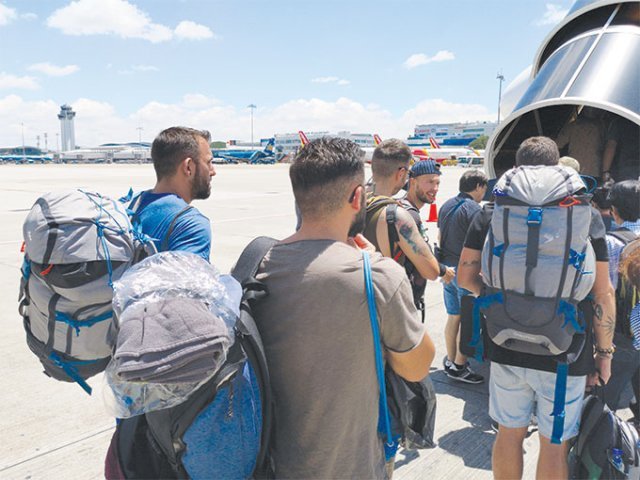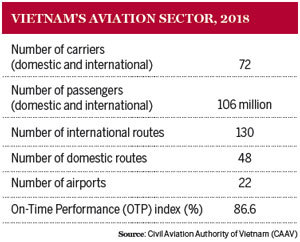 |
Most international tourists arrive in Vietnam by air, and industry analysts have pointed out that the interaction between aviation and tourism is tight and symbiotic: aviation benefits greatly from tourism development and tourism can in turn develop further with an improved aviation sector.
But the overloading seen at many airports in the country indicates that the State needs to identify solutions to improve aviation infrastructure and meet the needs of the tourism sector, which was among a host of important factors identified by both industries at the “Solutions to Promoting the Sustainable Development of Vietnam’s Aviation Industry” workshop held in Quy Nhon city in south-central Binh Dinh province on April 11.
EXISTING BOTTLENECKS
 |
Figures from the Vietnam National Administration of Tourism (VNAT) show that in March alone the number of international visitors to Vietnam reached more than 1.4 million, of which those arriving by air was more than 1 million, or 77.5 per cent, up 2.3 per cent against March 2018.
Growth in arrivals by air leads Southeast Asia and will reach 17 per cent in the 2016-2021 period compared to a 6 per cent average in the region, according to the World Bank.
Mr. Dinh Ngoc Duc, Director of the Tourism Marketing Department at VNAT, told the workshop that more than 80 per cent of foreign visitors arrive in Vietnam by air, while the number of domestic tourists choosing to fly is also increasing.
“The relationship between aviation and tourism is like two aircraft wings,” he said.
Meanwhile, Mr. Lai Xuan Thanh, Chairman of the Board at Airports Corporation of Vietnam (ACV), told VET that aviation infrastructure not only meets the needs of the tourism sector but also contributes to economic development as Vietnam’s economy opens up and the country moves towards global integration.
A typical example of the impact of aviation on tourism can be found in Binh Dinh province, host of the workshop. Mr. Nguyen Phi Long, Deputy Chairman of the Binh Dinh Provincial People’s Committee, said that Quy Nhon was virtually forgotten as a destination until a few years ago.
“From two flights a day in 2015, Phu Cat Airport now serves 20 flights daily,” he added.
“The province expects to welcome 1-2 million visitors each year, but in the first quarter of this year alone Quy Nhon welcomed 1 million.”
Aviation infrastructure is clearly still to meet increasing demand from tourism. Many foreign tourists complain that heading to Quy Nhon, northern Quang Ninh and Thanh Hoa provinces, central Quang Binh province, or Phu Quoc Island involves at least two domestic flights.
They must go to major airports in Hanoi, Ho Chi Minh City or elsewhere then transfer to their destination.
Overloading at airports also forces passengers to wait a long time to get through check-in and security, to the detriment of overall service quality and the flying experience.
Mr. Pham Vu Nguyen Tung, Project Director at Vietjet Air, took the example of Dien Bien province, a prominent historic destination in the country’s northwest but lacking in airport infrastructure. “Large aircraft can’t land at Dien Bien,” he said.
“We have proposed investing in the airport but there are many issues to address. But if a large airport was built, it would promote overall socioeconomic development in the local area.”
Overloading at certain airports has affected the development of both aviation and tourism and is a familiar scene every year during the tourism season.
Tan Son Nhat International Airport, for example, is now operating at 130 per cent capacity, according to the Civil Aviation Authority of Vietnam (CAAV).
ACV reported that during this year’s Tet holiday in early February, Tan Son Nhat welcomed 142,000 passengers but “struggled” to cater to 900. Other airports like Noi Bai in Hanoi, Da Nang, or Cam Ranh, near Nha Trang, are also bursting at the seams.
Vietnam’s population stands at well over 90 million people and it welcomed about 15 million international tourists last year, but the country has just 22 airports. The number of carriers is also much lower than in other ASEAN countries, at four, while Indonesia has 15, Thailand 13, Malaysia six, and the Philippines five.
When addressing the Vietnam Travel and Tourism Summit 2018 within the framework of the Vietnam Economic Forum (VEF) held last December, Deputy Prime Minster Vu Duc Dam said the growth in Vietnam’s tourism industry over recent times has been rapid and it will be extremely difficult to maintain such a pace.
“There is a certain threshold where the tourism industry will face challenges, given that problems in airport infrastructure can’t be resolved immediately or even within a year or two,” he added.
LONG-TERM SOLUTIONS
According to analysts, the airport investment model followed in Vietnam has largely depended upon public investment, which has proven insufficient given the state of the country’s airports.
It has therefore become necessary to promote private investment and private airport operations. Mr. Thanh agrees that aviation infrastructure development requires large sources of investment capital.
“The State has adopted a policy of mobilizing social resources into aviation infrastructure and private investment must guarantee a harmony of interest between investors and society,” he said.
“As a State-owned corporation with the role of investment development and management of aviation infrastructure, ACV is willing to work with private investors to meet the needs of the tourism sector in particular and the economy in general.”
Mr. Dang Tat Thang, Vice Chairman of Bamboo Airways, told the workshop that the participation of the private sector in aviation has given many more people the opportunity to fly, and competition between Vietnamese airlines will provide major benefits to passengers.
“Competition in the aviation market is not only between airlines but also between the State sector and the private sector,” he added.
“The State has played a role in guiding direction and policy, creating an equal environment between State and private.”
In January, Deputy Prime Minister Trinh Dinh Dung signed a decision approving the “Strengthening Aviation Connectivity with Tourist Source Markets” project.
The goal is to open up new routes and increase flight frequency on existing routes between Vietnam and key tourist markets around the world, such as the US, France, the UK, Japan, South Korea, and China.
New domestic routes will also be opened to connect the key tourist areas of the northeast, the central region, the south-central coast, the central highlands, the Mekong Delta, and Phu Quoc Island.
The Prime Minister has approved planning for aviation infrastructure, with total annual capacity is to stand at 104 million passengers by 2020 and 308 million by 2030.
From a local perspective, Ms. Vu Thi Thu Thuy, Vice Chairwoman of the Quang Ninh Provincial People’s Committee, home of Ha Long Bay, told the gathering that the province is committed to creating a flexible and transparent environment with favorable conditions for investors.
Meanwhile, in order for Phu Cat Airport to continue to develop further, Mr. Long said Binh Dinh province would be responsible for traffic infrastructure between Phu Cat Airport and Quy Nhon.
“At the end of this year, we will open a new route from the airport to the city,” he said. “We will also have policies to develop local tourism.” " VN Economic Times
Ngoc Lan
 The limitations plaguing Vietnam's aviation infrastructure need to be overcome to facilitate growth in the tourism sector.
The limitations plaguing Vietnam's aviation infrastructure need to be overcome to facilitate growth in the tourism sector.